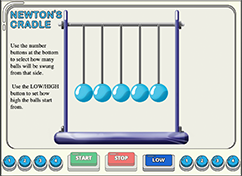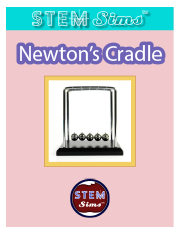What is energy?
At its most basic, energy is the ability to do work. Energy is in everything and comes in many different forms. Heat, light, sound, and electricity are all kinds of energy. Energy can make things move, make things change temperature, or can be stored. All energy is either potential energy or kinetic energy.
What is potential energy?
Potential energy is stored energy. Food that we eat has potential energy stored in chemical bonds. An object held far above the earth’s surface has potential energy due to gravity pulling it towards the ground.
What is kinetic energy?
Kinetic energy is the energy of motion. The amount of kinetic energy an object has is based on both its mass and its velocity. A mosquito flying along a train track has some kinetic energy; a train speeding down the track has much more kinetic energy.
What is the law of conservation of energy?
The law of conservation of energy says that energy cannot be created or destroyed- only change form. When a book is sitting on a table, it has potential energy due to gravity. If that book is pushed off of the table, the potential energy is decreasing as it gets closer to the ground. That energy is not disappearing, it is converted to kinetic energy as the book accelerates towards the ground.
What is momentum?
Momentum is the force of an object in motion. Like kinetic energy, it is based on both the mass and velocity of a moving object. It is also a conserved quantity- meaning it cannot be either created or destroyed. It is different from kinetic energy in a few key ways. First, momentum is dependent on direction, while kinetic energy is not. Secondly, momentum increases steadily as velocity increases, while kinetic energy increases exponentially (much more rapidly) as velocity increases.
What is a Newton’s Cradle?
Newton’s Cradle is a popular desktop toy with several balls suspended in a row. As one ball is raised on one side and dropped towards those at rest, it demonstrates the conversion of potential energy to kinetic energy. As that ball collides into those at rest, its momentum travels down the line of balls and causes the last ball to swing out to the same height at which the first ball was released. This motion continues as that ball in turn falls back towards those at rest.
Here are some definitions to help you in your Grade 3-5 Lesson 1 investigation.
Motion – a change in position of something
Prediction – a statement of what will happen in the future
Observation – to use senses such as sight, touch, smell, and/or hearing to describe something
Sphere – the shape of a ball
Collision – when two or more things run into each other
Patterns – something that happens in a regular and repeating way
Explanation – to tell what and/or why something happened
Construct – to make or write something
Mass – the amount of matter in something
Cause – something that gives rise to an action
Effect – an outcome or result
Here are some definitions to help you in your Grade 3-5 Lesson 2 investigation.
Motion – a change in position of something
Sphere – the shape of a ball
Collision – when two or more things run into each other
Patterns – something that happens in a regular and repeating way
Explanation – to tell what and/or why something happened
Construct – to make or write something
Mass – the amount of matter in something
Energy – the ability to do work
Potential Energy – energy that is stored due to position
Kinetic Energy – energy due to motion
Gravity – a force pulling objects down due to the mass of Earth
Cause – something that gives rise to an action
Effect – an outcome or result
 The Newton's Cradle is a device that has fascinated people for many decades. Pull back a sphere and see what happens. Pull back two spheres and something different happens. Can you determine how the cradle works? Get some energy and gain some momentum to investigate Newton's Cradle.
The Newton's Cradle is a device that has fascinated people for many decades. Pull back a sphere and see what happens. Pull back two spheres and something different happens. Can you determine how the cradle works? Get some energy and gain some momentum to investigate Newton's Cradle.


